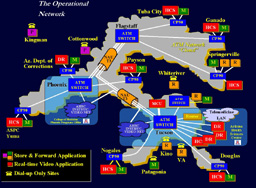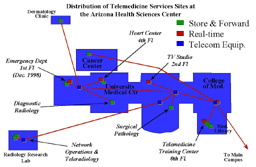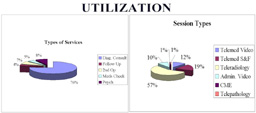Invited
Symposium
Presentation
| INABIS '98 Home Page | Your Symposium | Related Symposia & Posters | Scientific Program | Exhibitors' Foyer | Personal Itinerary | New Search |
Telemedicine/Teleradiology
Contact Person: Contact
Person: Kevin M. McNeill, Ph.D. (kevin@radiology.arizona.edu)
Results
Telemedicine Services
Fig. 1: Schematic of the Arizona Rural Telemedicine Network.
Currently eight remote client sites are connected to the Arizona Rural Telemedicine Network via T1 (1.544 Mbps) based ATM. All of these sites utilize both real-time interactive consultation and store and forward applications. Six other sites are using dial-up access for store and forward operation. Three of these are only teleradiology, two are only telepathology and one is general telemedicien. A recent grant will allow one of the dial-up teleradiology sites, at Whiteriver, to be converted to a full service, ATM network client site by the end of 1998.The ATM network is built upon dedicated T1 circuits with a backbone of three enterprise ATM switches located in the northern, central and southern parts of the state. Each remote client site connects to the network by a T1 to the nearest switch site. An ATM edge device at the client site provides the interface between the applications equipment and the ATM network.
Fig. 2: Distribution of Service Sites at the Arizona Health Sciences Center.
Telemedicine service support is distributed across several locations in the Arizona Health Sciences Center. A training and consultation center provides systems for both interactive and store and forward applications. These systems are used by site coordinators for clinical interaction with the remote client sites. The center also supports training by providing an operational configuration identical to the configuration of the client sites, as well as the consulting room for real-time interactive video. During training sessions the students can see both the client and consultant sides of the interaction. The client configuration provides all of the system components used by the remote sites to faclitiate hands on training activities. Teleradiology is supported by a new dedicated facility in the department of radiology, linked to the training room by fiber optics. This facility provides a dedicated image viewing station for teleradiology applications to allow radiologists to provide services from their department. Servers for both store and forward systems are located at the Radiology Research Lab in an adjacent building also linked by fiber.
Fig. 3: Telemedicine Utilization.
Remote client sites have come on-line approximately
every two or three months over the period from July 1997
to July 1998, with a new site added in early October 1998
and another scheduled to be on-line by the end of 1998.
The determining factor is usually the delivery schedule
for the telecommunications services leased from the
carriers. The types of services provided, and the
telemedicine modalities used are illustrated in Figure 3.
Store and forward services are most heavily used with
Teleradiology making up the largest number of sessions.
This is similar to the experience of most Telemedicine
programs which have found that many sub-specialities more
naturally fit the asynchronous nature of store and
forward services. Difficulties in scheduling also
contribute to the less frequent use of interactive video.
Professional Education
The video conferencing resources used for interactive telemedicine consultations also provide the capability to make continueing medical education programming available to the remote client sites. This programming can be in the form of one-way broadcasts of taped materials, or multi-site interactive video conferencing to support the participation of the remote site during Grand Rounds. To facilitate this application a video Multi-point Control Unit (MCU) is connected to the ATM switch located at the AHSC. By configuring virtual circuits in the ATM network those remote sites participating in an educational programming event are linked into the MCU. The MCU itself takes care of the video switching necessary to support the conference. Sites not participating in a multi-point conference may still utilize the network to hold clinical interactions, limited by the availability of bandwidth on the backbone. Educational programming originates in the analog TV system operated by Biomedical Communications and is sent to the telemedicine network through a dedicated video codec which converts the video into digital format. Broadcast materials may be downlinked from national satellite service through general university resources which are tied into the educational video network.
Telemedicine Technology Assesment
The technology assesment component of the telemedicine program is based in the Radiology Research Laboratory. Laboratory space and computer based tools are available to facilitate evaluation of equipment based on ROC (Receiver-Operator Characteristics) Analysis, user interface analysis and technical evaluation of digital components of the network and applications equipment. An ATM switch in the laboratory provides for the capability of testing applications or communications equipment without impacting the operational network or using up switch ports. The laboratory also houses the network management center where system provide the capability to manage and trouble-shoot the remote network equipment from a central location.
Telemedicine Training
Training courses are help approximately every six months or so as appropriate when new sites come on-line or skills need to be refreshed for the rural sites. The training program is comprehensive and covers all aspects of the telemedicine program. The outline of the program for the two-day course usually offered is the following:
Arizona Telemedicine Program |
|
1st Day |
|
8:15 - 9:15 |
Breakfast, Welcoming
Remarks, Orientation, Program Objectives Program Overview Break Introduction to Telemedicine Technologies Telemedicine Evaluation & Assessment Lunch Photograph Clinical Applications Telecommunications Fundamentals Break Home Health Nursing Education Programs Reception Telemedicine laboratory I |
2nd Day |
|
8:30
- 9:00
|
The Business of
Telemedicine Legal Issues Break Videoconferencing technology, patient presentations Department of Corrections Telemedicine Lunch Telemedicine Specialty Services: Psychiatry, Dermatology, Cardiology, Neurology, etc. Telemedicine Laboratory II |
Back to the top.
Presentation Number SAmcneill0213
Keywords: Telemedicine,
Teleradiology, Real-time, Store-and-forward, Interactive,
Network
| Discussion Board | Next Page | Your Symposium |


